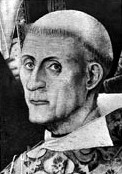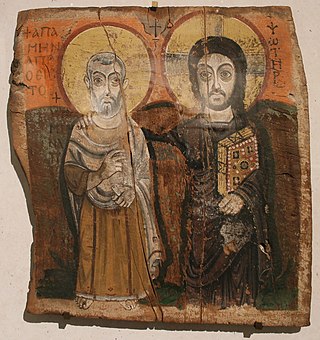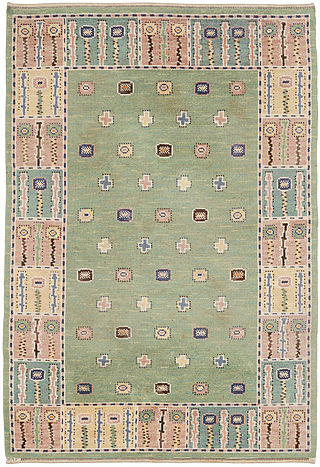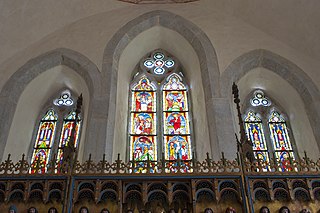
Freyr, sometimes anglicized as Frey, is a widely attested god in Norse mythology, associated with kingship, fertility, peace, prosperity, fair weather, and good harvest. Freyr, sometimes referred to as Yngvi-Freyr, was especially associated with Sweden and seen as an ancestor of the Swedish royal house. According to Adam of Bremen, Freyr was associated with peace and pleasure, and was represented with a phallic statue in the Temple at Uppsala. According to Snorri Sturluson, Freyr was "the most renowned of the æsir", and was venerated for good harvest and peace.

The Bayeux Tapestry is an embroidered cloth nearly 70 metres long and 50 centimetres tall that depicts the events leading up to the Norman Conquest of England in 1066, led by William, Duke of Normandy challenging Harold II, King of England, and culminating in the Battle of Hastings. It is thought to date to the 11th century, within a few years of the battle. Now widely accepted to have been made in England perhaps as a gift for William, it tells the story from the point of view of the conquering Normans and for centuries has been preserved in Normandy.

Tapestry is a form of textile art, traditionally woven by hand on a loom. Normally it is used to create images rather than patterns. Tapestry is relatively fragile, and difficult to make, so most historical pieces are intended to hang vertically on a wall, or sometimes horizontally over a piece of furniture such as a table or bed. Some periods made smaller pieces, often long and narrow and used as borders for other textiles. Most weavers use a natural warp thread, such as wool, linen, or cotton. The weft threads are usually wool or cotton but may include silk, gold, silver, or other alternatives.

The Ardre image stones are a collection of ten rune and image stones, dated to the 8th to 11th centuries, that were discovered at Ardre Church, in Ardre, Gotland, Sweden. The principal edition is by Sune Lindqvist.

The Swedish History Museum is a museum located in Stockholm, Sweden, that covers Swedish archaeology and cultural history from the Mesolithic period to present day. Founded in 1866, it operates as a government agency and is tasked with preserving Swedish historical items as well as making knowledge about history available to the public.

Bernt Notke was a late Gothic artist from the Baltic region. He has been described as one of the foremost artists of his time in northern Europe.

Coptic art is the Christian art of the Byzantine-Greco-Roman Egypt and of Coptic Christian Churches. Coptic art is best known for its wall-paintings, textiles, illuminated manuscripts, and metalwork, much of which survives in monasteries and churches. The artwork is often functional, as little distinction was drawn between artistry and craftsmanship, and includes tunics and tombstones as well as portraits of saints. The Coptic Museum in Coptic Cairo houses some of the world's most important examples of Coptic art.

The Överhogdal tapestries are a group of extraordinarily well-preserved textiles dating from the late Viking Age or the Early Middle Ages that were discovered in the village of Överhogdal in Härjedalen, Sweden.

Carpets and rugs have been handmade in Sweden for centuries, taking on many different forms and functions over the course of time. Rugs woven in the traditional Oriental manner, especially in the Ottoman Empire and points east, were originally brought to Sweden over trade routes as early as the early Middle Ages. In the centuries that followed, Swedish rug-makers often infused their works with themes and motifs traditionally found in Oriental rugs. Eventually, Swedish rug-makers would begin to use Oriental rug-making techniques, but themes and motifs more consistent with the artistic and cultural heritage of Sweden. By the early modern periods, rugs had long been an important avenue of art – especially folk art – in Swedish culture. By the beginning of the twentieth century, the craft was seen as being an important artistic and cultural practice throughout Sweden, and designers began to make rugs that had a broad international appeal. Swedish rugs from the mid-twentieth century remain among the most desirable and sought after in the rug world.

Lye Church is a medieval church on Gotland, Sweden. The oldest parts of the church date from the last quarter of the 12th century, and the last major addition was the disproportionately large chancel, built during the second quarter of the 14th century by a workshop known by its notname as Egypticus. The workshop was also responsible for constructing the largest of the church portals, which is also decorated with Gothic stone sculpture. The tower portal contains sculptures attributed to the Romanesque sculptor Sigraf. The church has been little altered since the end of the Middle Ages. Lye Church contains the largest preserved set of medieval stained glass windows in the Nordic countries, and its interior is also decorated by medieval wall paintings, uncovered in the 1950s. The altarpiece is from 1496, and the church also contains a triumphal cross from the same period.

Lärbro Church is a medieval church in Lärbro on the Swedish island of Gotland. The church is located at a former strategically important spot, as testified by the adjacent fortified tower. The presently visible Gothic church replaced an earlier Romanesque church during the 13th and 14th century. The cemetery of the church contains several graves of victims from Nazi concentration camps who were taken to a field hospital in Lärbro during and after World War II.

Rö Church is a medieval Lutheran church in the Archdiocese of Uppsala in Stockholm County, Sweden.

Church murals or church wall paintings are mostly medieval paintings found in several Swedish churches. They usually adorn the vaults or walls of the buildings. In Swedish they are sometimes referred to as kalkmålningar, literally "lime paintings", since they were often painted using lime as the binding medium for the paint. The earliest church murals in Sweden date from the first decades of the 12th century and are Romanesque in style. The majority of these are found in the southern part of Sweden, where they were commissioned by members of the royalty and nobility of the time. They all have certain iconographic similarities, and for the most part, show stylistic influences from contemporary art in what is now Germany. While it is assumed that the artists who painted the murals were well-educated, and the first of them foreigners, virtually nothing is known about their identities. Around 1250, there was a stylistic shift towards Gothic that saw lighter and more airy compositions and the rising popularity of Marian and Christian mystic motifs. Early and High Gothic murals are preserved, especially on the island of Gotland, where many new churches were built at the time, and in Scania, where many older churches were equipped with new vaults which were then decorated. The earliest known names of the artists date from this time.

Barlingbo Church is a medieval church in Barlingbo on the Swedish island of Gotland. It dates from the 13th century and has been altered little since. It contains furnishings from several centuries, including an unusual medieval baptismal font, decorated with figures and runes. The church belongs to the Church of Sweden and lies in the Diocese of Visby.

Rone Church is a medieval church in Rone on the Swedish island of Gotland. The Gothic church contains a number of medieval murals. It is part of the Church of Sweden and lies in the Diocese of Visby.

Grödinge tapestry is a type of handwoven tapestry that is on display at the Swedish History Museum in Stockholm, Sweden. It originates from the Grödinge Church in the Diocese of Strängnäs at Botkyrka Municipality in Södermanland County, Sweden. The tapestry was donated to the Swedish History Museum in 1910.

The surviving amount of medieval stained glass in Sweden is relatively small, compared to some other European countries. There are in total 165 medieval stained glass panes with figurative depictions surviving in 37 churches, constituting a total area of about 60 square metres (650 sq ft), a fragment of the original amount but still the largest amount found in any of the Nordic countries. Archaeological evidence and old drawings indicate that many more once existed.

The Khalili Collection of Swedish Textiles is a private collection of textile art assembled by the British-Iranian scholar, collector and philanthropist Nasser D. Khalili. The collection was built up over a period of 25 years and contains 100 works. It is one of eight collections assembled, conserved, published and exhibited by Khalili, each of which is considered among the most important in its field. In 2008 it was described as "the only extensive collection of Swedish flatweaves outside the country". The collection consists mostly of textile panels, cushion and bed covers from the Scania region of southern Sweden, dating in the main from a hundred-year period between the mid-18th and mid-19th centuries. The majority of the pieces in the collection were made for wedding ceremonies in the region. While they played a part in the ceremonies, they were also a reflection of the artistry and skill of the weaver. Their designs often consist of symbolic illustrations of fertility and long life. Khalili writes that he created the collection because of the tendency of art historians and the public to undervalue art whose creators are anonymous.

Brönnestad Church is a church in Brönnestad, a village in Hässleholm Municipality, Sweden. The church was built in the 12th century and has been successively enlarged in the following centuries. In the 15th century, the interior was decorated with murals, stylistically and iconographically unusual for a Swedish context. They were rediscovered under layers of whitewash and restored during the 20th century.

Decorative painting in Hälsingland has been practiced as a folk art tradition in the region since the 16th century. Employed as a means of interior decoration in Hälsingland farmhouses, the tradition has been practiced by mostly self-taught and now forgotten artists. Wall paintings were usually performed with distemper after covering the hard wooden surface with coarse linen. Decorative painting of furniture was also a ubiquitous manifestation of the art style. Religious themes were predominant until the 18th century, after which the selection of motifs became more diverse. The first reliable attributions of preserved interiors to named artists concern works from that time period. During the early 19th century classically trained artists started participating in and influencing the art style, while an influx of folk artists skilled in the Dalcarlian tradition made their mark in the region. The practice of decorating walls with the assistance of stencils was also introduced as a more economical alternative to fashionable, but still very expensive printed wallpaper. By the end of the 19th century the folk art tradition had degenerated and went into decline.























